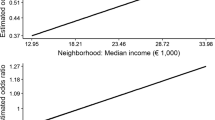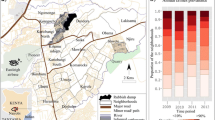Abstract
The purpose of this article is to examine whether robbery rates and select robbery characteristics differ between gated and non-gated residential communities. We use NCVS data to assess frequencies and robbery characteristics of gated and non-gated residential communities. There were no statistically significant differences in robbery rates between gated and non-gated complexes. Our null finding is surprising given the perceived crime prevention benefits of gating. The article explores gating’s potential role in the prevention and/or amplification of residential robbery. Attention is given to the role of natural surveillance, collective efficacy and sanction threats in this regard.
Similar content being viewed by others
Notes
As is the case with most violent crime, robberies are relatively rare. To place these numbers into context, the unweighted number of robberies reported for 2013 was 150 with 71 occurring at or near the victim’s home.
Pooling years of NCVS data to study relatively rare events is not uncommon in published studies. It is one way of exploiting the rich detail collected by the NCVS while addressing the small case sizes. One limitation with this technique is that it could influence our findings, and this is a caveat with our study and the findings obtained. However, given the dearth of available data to study this topic, we believe our work provides a useful starting point and foundation upon which future work can build. We thank an anonymous reviewer for raising this concern.
Estimates of the population living in gated and non-gated communities are based on the weighted NCVS person level file.
Such a study would likely require original data collection efforts. Secondary data collected from the police such as the Uniform Crime Reporting (UCR) Program permit city-level estimates, but even the UCR’s more detailed National Incident-Based Reporting System does not identify locations of residential robberies as occurring in gated communities or not.
Over three-quarters (81 per cent) of gated home robberies were not committed by a friend of the victim, which supports the notion that offenders can legitimately have access to stranger-victims.
Two clerks do not appear to reduce robbery rates and when injury-producing robberies result, the risk of violent victimization is doubled (see Amandus et al, 1997).
References
Abdullah, A., Salleh, M.N.M. and Sakip, S.R.M. (2012) Fear of crime in gated and non-gated residential areas. Procedia – Social and Behavioral Sciences 35: 63–69.
Addington, L.A. and Rennison, C.M. (2015) Keeping the barbarians outside the gate? Comparing burglary victimization in gated and non-gated communities. Justice Quarterly 32 (1): 168–192.
Alarid, L.F., Burton, V.S. and Hochstetler, A.L. (2009) Group and solo robberies: Do accomplices shape criminal form? Journal of Criminal Justice 37 (1): 1–9.
Allison, P. (2002) Missing Data. Thousand Oaks, CA: Sage Publications.
Amandus, H.E. et al (1997) Convenience store robberies in selected metropolitan areas: Risk factors for employees injury. Journal of Occupational and Environmental Medicine 39 (5): 442–447.
Atkinson, R. and Flint, J. (2004) Fortress UK? Gated communities, the spatial revolt of the elites and time-space trajectories of segregation. Housing Studies 19 (6): 875–892.
Atlas, R. and LeBlanc, W. (1994) The impact on crime of street closures and barricades: A Florida case study. Security Journal 5 (3): 140–145.
Benjamin, R. (2012) The gated community mentality. New York Times 29 March.
Blakely, E.J. and Snyder, M.G. (1997) Fortress America: Gated Communities in the United States. Washington DC: Brookings Institution Press.
Blakely, E.J. and Snyder, M.G. (1998) Separate places: Crime and security in gated communities. In: M. Felson and R.B. Peiser (eds.) Reducing Crime Through Real Estate Development and Management. Washington DC: Urban Land Institute, pp. 53–70.
Bowers, K.J., Johnson, S.D. and Hirschfield, A.F.G. (2004) Closing off opportunities for crime: An evaluation of alley-gating. European Journal on Criminal Policy and Research 10 (4): 285–308.
Breetzke, G.D. and Cohn, E.G. (2013) Burglary in gated communities an empirical analysis using routine activities theory. International Criminal Justice Review 23 (1): 56–74.
Brown, B.B., Perkins, D.D. and Brown, G. (2004) Incivilities, place attachment and crime: Block and individual effects. Journal of Environmental Psychology 24: 359–371.
Bureau of Justice Statistics (2015a) Percent of robberies by location of incident, 2013. Generated using the NCVS Victimization Analysis Tool. www.bjs.gov, accessed 25 April 2015.
Bureau of Justice Statistics (2015b) National crime victimization survey: Technical documentation. Washington DC: US Department of Justice. http://www.bjs.gov/content/pub/pdf/ncvstd13.pdf, accessed 9 October 2015.
Cloward, R. and Ohlin, L. (1960) Delinquency and Opportunity. New York: Free.
Cohen, J., Cohen, P., West, S.G. and Aiken, L.S. (2003) Applied Multiple Regression/Correlation Analysis in the Behavioral Sciences. 3rd edn. Mahwah, NJ: Erlbaum.
Contreras, R. (2009) “Damn, Yo—Who’s That Girl?” An Ethnographic Analysis of Masculinity in Drug Robberies. Journal of Contemporary Ethnography 38 (4): 465–492.
Copes, H., Hochstetler, A. and Cherbonneau, M. (2012) Getting the upper hand: Scripts for managing victim resistance in carjackings. Journal of Research in Crime and Delinquency 49 (2): 249–268.
Cromwell, P. and Olson, J. (2004) Breaking and Entering: Burglars on Burglary. Belmont, CA: Wadsworth.
Danielsen, K.A. (2007) How the other half lives: Tenure differences and trends in rental gated communities. Housing Policy Debate 18 (3): 503–534.
Davis, L. (2003) Carjacking: Insights from South Africa to a new crime problem. The Australian and New Zealand Journal of Criminology 36 (2): 173–191.
Donnelly, P. and Kimble, C. (1997) Community organizing, environmental change, and neighborhood crime. Crime and Delinquency 43 (4): 493–511.
Dupuis, A. and Thorns, D. (2008) Gated communities as exemplars of ‘forting up’ practices in a risk society. Urban Policy and Research 26 (2): 145–157.
Erickson, R.J. (1996) Armed Robbers and their Crimes. Seattle: Athena Research Corporation.
FBI (2012) Crime in the United States. Washington DC.
Feeney, F. (1986) Robbers as decision makers. In: D. Cornish and R. Clarke (eds.) The Reasoning Criminal. New York: Springer-Verlag, pp. 55–71.
Finland, M. (1979) Emergence of antibiotic resistance in hospitals, 1935–1975. Review of Infectious Diseases 1: 4–22.
Fowler, F.J. and Mangione, T.W. (1986) A three-pronged effort to reduce crime and fear of crime: The Hartford experiment. In: D.P. Rosenbaum (ed.) Community Crime Prevention: Does it Work? Newbury Park, CA: Sage, pp. 87–108.
Gabor, T., Caril, M., Cusson, M., Elie, D., LeBlanc, M. and Normandeau, A. (1987) Armed Robbery: Cops, Robbery, and Victims. Springfield, IL: Charles C Thomas.
Gibbs, J.P. (1975) Crime, Punishment, and Deterrence. New York: Elsevier.
Grant, J. and Mittelsteadt, L. (2004) Types of gated communities. Environment and Planning B: Planning and Design 31 (6): 913–930.
Helsley, R.W. and Strange, W.C. (1999) Gated communities and the economic geography of crime. Journal of Urban Economics 46 (1): 80–105.
Hirschi, T. (1969) Causes of Delinquency. Berkeley, CA: University of California Press.
Hochstetler, A. (2001) Opportunities and decisions: Interactional dynamics in robbery and burglary groups. Criminology 39 (3): 737–764.
Jacobs, B.A. (2000) Robbing Drug Dealers: Violence Beyond the Law. New York: Aldine de Gruyter.
Jacobs, B.A. (2012) Carjacking and copresence. Journal of Research in Crime and Delinquency 49 (4): 471–488.
Jacobs, B.A. (2013) The manipulation of fear in carjacking. Journal of Contemporary Ethnography 42 (5): 523–544.
Jacobs, B.A. and Wright, R.T. (2006) Street Justice: Retaliation in the Criminal Underworld Network. Cambridge: Cambridge University Press.
Jeffery, C.R. (1971) Crime Prevention Through Environmental Design. Beverly Hills, CA: Sage Publications.
Kenna, T. (2010) Fortress Australia? (In)security and private governance in a gated residential estate. Australian Geographer 41 (4): 431–446.
Koper, C. (1995) Just enough police presence: Reducing crime and disorderly behavior by optimizing patrol time in crime hotspots. Justice Quarterly 12 (4): 649–672.
Lasley, J. (1996) “Designing Out” Gang Homicides and Street Assaults. Washington DC: National Institute of Justice, U.S. Department of Justice.
Lohr, S.L. (2010) Sampling: Design and Analysis. 2nd edn. Boston, MA: Cengage Learning.
Low, S.M. (2001) The edge and the center: Gated communities and the discourse of urban fear. American Anthropologist 103 (1): 45–58.
Lowman, J. (1992) Street prostitution control: Some Canadian reflections on the Finsbury park experience. British Journal of Criminology 32 (1): 1–17.
Luckenbill, D. (1981) Generating compliance: The case of robbery. Urban Life 10 (1): 25–46.
Matthews, R. (1993) Kerb-Crawling, Prostitution, and Multiagency Policing. Crime Prevention Unit Series, Paper 43. London: Home Office.
McKenzie, E. (2005) Constructing the pomerium in Las Vegas: A case study of emerging trends in American gated communities. Housing Studies 20 (2): 187–203.
Merton, R.K. (1938) Social structure and anomie. American Sociological Review 3 (5): 672–682.
Miethe, T. and Sousa, W.H. (2009) Carjacking and its consequences: A situational analysis of risk factors for differential outcomes. Security Journal 23 (4): 241–258.
Miller, W. (1958) Lower-class culture as a generating milieu of gang delinquency. Journal of Social Issues 14 (3): 5–19.
Nguyen, D.P. (2004) Jury awards $10-million more: The owner of Remington apartment homes is punished for failing to protect a tenant who was shot. Tampa Bay Times 17 December.
Poyner, B. (1983) Design Against Crime: Beyond Defensible Space. London: Butterworths.
Reckless, W.C. (1961) The Crime Problem. New York: Appleton Century Crofts.
Rennison, C.M. and Rand, M.R. (2007) Introduction to the national crime victimization survey. In: J.P. Lynch and L.A. Addington (eds.) Understanding Crime Statistics: Revisiting the Divergence of the NCVS and the UCR. New York, NY: Cambridge University Press, pp. 17–54.
Romig, K. (2005) The upper sonoran lifestyle: Gated communities in Scottsdale, Arizona. City & Community 4 (1): 67–86.
Sampson, R.J. and Laub, J.H. (1993) Crime in the Making: Pathways and Turning Points Through Life. Cambridge, MA: Harvard University Press.
Sampson, R.J., Raudenbush, S.W. and Earls, F. (1997) Neighborhoods and violent crime: A multilevel study of collective efficacy. Science 277 (5328): 918–924.
Sanchez, T.W., Lang, R.E. and Dhavale, D.M. (2005) Security vs. status?: A first look at the census’s gated community data. Journal of Planning Education and Research 24 (3): 281–291.
Sherman, L.W. (1995) Public regulation of private crime prevention. Annals of the American Academy of Political and Social Science 539 (1): 102–113.
Simon, J. (2007) Governing Through Crime: How the War On Crime Transformed American Democracy and Created a Culture of Fear. New York, NY: Oxford University Press.
US Bureau of the Census (2008) National Crime Victimization Survey CAPI Manual for Field Representatives, http://www.bjs.gov/content/pub/pdf/manual08.pdf, accessed 9 October 2015.
Vesselinov, E. (2008) Members only: Gated communities and residential segregation in the metropolitan United States. Sociological Focus 23 (3): 536–555.
Vilalta, C.J. (2011) Fear of crime in gated communities and apartment buildings: A comparison of housing types and a test of theories. Journal of Housing and the Built Environment 26 (2): 107–121.
Wagner, A. (1997) A study of traffic pattern modifications in an urban crime prevention program. Journal of Criminal Justice 25 (1): 19–30.
Weisel, D.L. (2007) Bank Robbery. Washington DC: United States Department of Justice.
Wilson-Doenges, G. (2000) An exploration of sense of community and fear of crime in gated communities. Environment and Behavior 32 (5): 597–611.
Wright, R.T. and Decker, S.H. (1994) Burglars on the Job. Boston, MA: Northeastern University Press.
Wright, R.T. and Decker, S.H. (1997) Armed Robbers in Action: Stickups and Street Culture. Boston, MA: Northeastern University Press.
Zavoski, R., Lapidus, G., Lerer, T., Burke, G. and Banco, L. (1999) Evaluating the impact of a street barrier on urban crime. Injury Prevention 5 (1): 65–68.
Author information
Authors and Affiliations
Corresponding author
Rights and permissions
About this article
Cite this article
Jacobs, B., Addington, L. Gating and residential robbery. Crime Prev Community Saf 18, 19–37 (2016). https://doi.org/10.1057/cpcs.2015.19
Published:
Issue Date:
DOI: https://doi.org/10.1057/cpcs.2015.19




